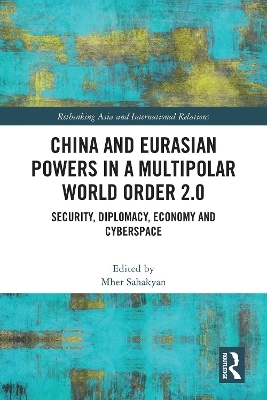
China and Eurasian Powers in a Multipolar World Order 2.0
Routledge (Verlag)
978-1-032-40336-6 (ISBN)
This book argues that the world order is no longer unipolar, and the war in Ukraine proves this fact. As this study describes and theorizes, it has been transformed into a Multipolar World Order 2.0 stage. This title critically examines Chinese, US, Russian, EU, Indian, and a number of other powers’ cooperation and competition over security, diplomatic, economic and cyberspace issues.
Accomplished scholars from various regions of the Eurasian continent consider the impact of the Russo–Ukrainian war, the Sino–Russian strategic partnership, China’s relations with the United States and the European Union, the influence of the Belt and Road Initiative, the expansion of the Shanghai Cooperation Organization and Eurasian Economic Union, China’s policies in the Middle East, Central Asia, Indo-Asia Pacific, the South Caucasus, Central and Eastern Europe, as well as focus on details of growing contradictions and collaboration in the Eurasian continent over markets, technologies, digital leadership, vaccine distribution, and financial institutions in the Era of Multipolar World Order 2.0.
Showing that the US-centred unipolar world order is replaced by Multipolar World Order 2.0 where conflicting powers fight to keep or extend their spheres of influence, this volume is of great interest to decision makers, diplomats, scholars and students of international relations, politics, global governance, Eurasian studies, Chinese studies, cybersecurity, and economics, and for those studying human security, international organizations, and geopolitics.
Mher Sahakyan is an 2022 AsiaGlobal Fellow of the Asia Global Institute of the University of Hong Kong. Mher holds a doctorate in international relations from China’s Nanjing University. He is the founder and director of the China-Eurasia Council for Political and Strategic Research, a foundation in Armenia. Mher Sahakyan also founded the annual international conference, Eurasian Research on Modern China and Eurasia. He is an elected advisory board member of the International Institute for Peace, Austria, and the School of Liberal Arts & Humanities, Woxsen University, India. Mher is also a member of the British Association for Chinese Studies, the Asia Society of Hong Kong and the International Political Science Association. He is a lecturer at the Russian-Armenian University and Yerevan State University. He is the author of the book China’s Belt and Road Initiative and Armenia, which was published in Armenian and in Russian and was shortlisted by the International Convention of Asia Scholars in Leiden, Netherlands, for its 2021 book prize. He is also author of The New Great Power Competition in Central Asia: Opportunities and Challenges for the Gulf, a contribution published in 2021 by the Anwar Gargash Diplomatic Academy in the United Arab Emirates. He is co-editor (with Heinz Gärtner) of China and Eurasia: Rethinking Cooperation and Contradictions in the Era of Changing World Order, published by Routledge in September 2021.
Contents List of Figures Notes on Contributors Preface in Chinese Acknowledgements Foreword: Great Power conflict PART I China, Great Powers and Eurasian Security 1. Political and economic security in multipolar Eurasia: English school perspective 2. Eurasia and the Pacific as the "Golden apple of discord" between the US and China: the cases of Afghanistan, Ukraine, the AUKUS and Quad 3.The US and China as main powers in the Multipolar world order 2.0: a case study Turkey and the Middle East PART II:
Sino-Russian strategic partnership in Eurasia: politics, economy, trade and interregional interaction 4.The strengthening of the Sino-Russian partnership in the the era of the Multiplolar world order 2.0 5. Russo-Chinese trade and economic cooperation: achievements and challenges 6. Interregional interaction between China and Russia on the Russo-Chinese border in the context of the COVID-19 Pandemic PART III:
Shanghai Cooperation Organization, Belt and Road Initiative’s China-Central Asia-Western Asia and Bangladesh-China-India-Myanmar economic corridors 7. China in Central Asia: the Shanghai Cooperation Organization, new developments and roles in 2013-2021 8.China’s Belt and Road Initiative and South Caucasus in the Era of Ukrainian war and Multipolar world order 2.0 9. Bangladesh and Belt and Road Initiative: strategic rationale and plausible repercussions PART IV: European subcontinent and China 10. China and the European Union: more partners than rivals? 11. Chinese relations with Central and Eastern European Countries in an era of Multipolar world order 2.0 PART V: Cybersecurity challenges, Digital Silk Road, and innovations in Eurasia 12. China’s Digital Silk Road: empowering capabilities for digital leadership in Eurasia 13. BRI’s Digital Silk Road and the EU: the role of innovation and communication in the Italian case study 14. Cybersecurity challenges between the EU and China and the way forward: thoughts and recommendations PART VI: The strategy of Communist Party of China: the historical experience and roadmap for the future 15. Comprehensive analysis of Resolution of the Central Committee of the Communist Party of China on the Major Achievements and Historical Experience of the Party over the Past Century PART VII Conclusion 16. Conclusion: colliding interests in Ukraine, Eurasia, and cyberspace in the era of Multipolar world order 2.0 Index
| Erscheinungsdatum | 16.03.2023 |
|---|---|
| Reihe/Serie | Rethinking Asia and International Relations |
| Zusatzinfo | 3 Tables, black and white; 5 Line drawings, black and white; 7 Halftones, black and white; 12 Illustrations, black and white |
| Verlagsort | London |
| Sprache | englisch |
| Maße | 156 x 234 mm |
| Gewicht | 508 g |
| Themenwelt | Sozialwissenschaften ► Politik / Verwaltung ► Europäische / Internationale Politik |
| Sozialwissenschaften ► Soziologie ► Spezielle Soziologien | |
| ISBN-10 | 1-032-40336-5 / 1032403365 |
| ISBN-13 | 978-1-032-40336-6 / 9781032403366 |
| Zustand | Neuware |
| Haben Sie eine Frage zum Produkt? |
aus dem Bereich


